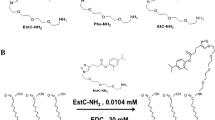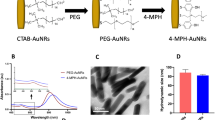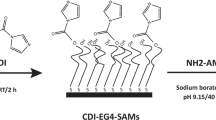Abstract
A peptide antibiotic, gramicidin A, was covalently bound to cystamine self-assembled monolayers on gold surfaces. Each step of the surface functionalization was characterized by polarization modulation infrared reflection absorption spectroscopy and X-ray photoelectron spectroscopy. The antimicrobial activity of the anchored gramicidin was tested against three Gram-positive bacteria (Listeria ivanovii, Enterococcus faecalis, and Staphylococcus aureus), the Gram-negative bacterium Escherichia coli and the yeast Candida albicans. The results revealed that the adsorbed gramicidin reduced, from 60% for E. coli to 90% for C. albicans, the number of culturable microorganisms attached to the surface. The activity was proven to be persistent overtime, up to 6 months after the first use. The bacteria attached to the functionalized surfaces were permeabilized as shown by confocal microscopy. Taken together, these results indicate a bacteriostatic mode of action of the immobilized peptide. Finally, using green fluorescent protein-expressing bacteria, it was shown that the development of a bacterial biofilm was delayed on peptide-grafted surfaces for at least 24 h.









Similar content being viewed by others
References
Andersen JB, Sternberg C, Poulsen LK, BjÃrn SP, Givskov M, Molin S (1998) New unstable variants of green fluorescent protein for studies of transient gene expression in bacteria. Appl Environ Microbiol 64(6):2240–2246
Aumsuwan N, McConnell MS, Urban MW (2009) Tunable antimicrobial polypropylene surfaces: simultaneous attachment of penicillin (gram +) and gentamicin (gram −). Biomacromolecules 10(3):623–629
Axelsson L, Katla T, Bjornslett M, Eijsink VG, Holck A (1998) A system for heterologous expression of bacteriocins in Lactobacillus sake. FEMS Microbiol Lett 168(1):137–143
Bechinger B, Lohner K (2006) Detergent-like actions of linear amphipathic cationic antimicrobial peptides. Biochim Biophys Acta 1758(9):1529–1539
Birnboim HC, Doly J (1979) A rapid alkaline extraction procedure for screening recombinant plasmid DNA. Nucleic Acids Res 7(6):1513–1523
Bosch A, Serra D, Prieto C, Schmitt J, Naumann D, Yantorno O (2006) Characterization of Bordetella pertussis growing as biofilm by chemical analysis and ft-ir spectroscopy. Appl Microbiol Biotechnol 71(5):736–747
Boujday S, Bantegnie A, Briand E, Marnet PG, Salmain M, Pradier CM (2008) In-depth investigation of protein adsorption on gold surfaces: correlating the structure and density to the efficiency of the sensing layer. J Phys Chem B 112(21):6708–6715
Chung D, Papadakis SE, Yam KL (2003) Evaluation of a polymer coating containing triclosan as the antimicrobial layer for packaging materials. Int J Food Sci Technol 38:165–169
Coello R, Charlett A, Ward V, Wilson J, Pearson A, Sedgwick J, Borriello P (2003) Device-related sources of bacteraemia in English hospitals—opportunities for the prevention of hospital-acquired bacteraemia. J Hosp Infect 53(1):46–57
Costerton JW, Stewart PS, Greenberg EP (1999) Bacterial biofilms: a common cause of persistent infections. Science 284(5418):1318–1322
Danese PN (2002) Antibiofilm approaches: prevention of catheter colonization. Chem Biol 9(8):873–880
Donelli G, Francolini I, Romoli D, Guaglianone E, Piozzi A, Ragunath C, Kaplan JB (2007) Synergistic activity of dispersin b and cefamandole nafate in inhibition of staphylococcal biofilm growth on polyurethanes. Antimicrob Agents Chemother 51(8):2733–2740
Donlan RM, Costerton JW (2002) Biofilms: survival mechanisms of clinically relevant microorganisms. Clin Microbiol Rev 15(2):167–193
Dowling DP, Donnelly K, McConnell ML, Eloy R, Arnaud MN (2001) Deposition of anti-bacterial silver coatings on polymeric substrates. Thin Solid Films 398:602–606
Dubos RJ, Cattaneo C (1939) Studies on a bactericidal agent extracted from a soil Bacillus. III. Preparation and activity of a protein-free fraction. J Exp Med 70(3):249–256
Dubos RJ, Hotchkiss RD (1941) The production of bactericidal substances by aerobic sporulating Bacilli. J Exp Med 73(5):629–640
Epand RM, Epand RF (2009) Lipid domains in bacterial membranes and the action of antimicrobial agents. Biochim Biophys Acta 1788(1):289–294
Foley SL, Lynne AM, Nayak R (2009) Molecular typing methodologies for microbial source tracking and epidemiological investigations of gram-negative bacterial foodborne pathogens. Infect Genet Evol 9(4):430–440
Giraffa G (2002) Enterococci from foods. FEMS Microbiol Rev 26(2):163–171
Guyomard A, Dé E, Jouenne T, Malandain J-J, Muller G, Glinel K (2008) Incorporation of a hydrophobic antibacterial peptide into amphiphilic polyelectrolyte multylayers: a bioinspired approach to prepare biocidal thin coatings. Adv Funct Mater 18:758–765
Hancock RE, Sahl HG (2006) Antimicrobial and host-defense peptides as new anti-infective therapeutic strategies. Nat Biotechnol 24(12):1551–1557
Hanna H, Benjamin R, Chatzinikolaou I, Alakech B, Richardson D, Mansfield P, Dvorak T, Munsell MF, Darouiche R, Kantarjian H, Raad I (2004) Long-term silicone central venous catheters impregnated with minocycline and rifampin decrease rates of catheter-related bloodstream infection in cancer patients: a prospective randomized clinical trial. J Clin Oncol 22(15):3163–3171
Huang HW (2006) Molecular mechanism of antimicrobial peptides: the origin of cooperativity. Biochim Biophys Acta 1758(9):1292–1302
Humblot V, Yala JF, Thebault P, Boukerma K, Hequet A, Berjeaud JM, Pradier CM (2009) The antibacterial activity of magainin i immobilized onto mixed thiols self-assembled monolayers. Biomaterials 30(21):3503–3512
Ignatova M, Labaye D, Lenoir S, Strivay R, Jerome R, Jerome C (2003) Immobilization of silver in polypyrrole/polyanion composite coatings: preparation, characterization, and antibacterial activity. Langmuir 19:8971–8979
Jayaraman A, Hallock PJ, Carson RM, Lee CC, Mansfeld FB, Wood TK (1999a) Inhibiting sulfate-reducing bacteria in biofilms on steel with antimicrobial peptides generated in situ. Appl Microbiol Biotechnol 52(2):267–275
Jayaraman A, Mansfeld FB, Wood TK (1999b) Inhibiting sulfate-reducing bacteria in biofilms by expressing the antimicrobial peptides indolicidin and bactenecin. J Ind Microbiol Biotechnol 22:167–175
Kelkar DA, Chattopadhyay A (2007) The gramicidin ion channel: a model membrane protein. Biochim Biophys Acta 1768(9):2011–2025
Khandelia H, Ipsen JH, Mouritsen OG (2008) The impact of peptides on lipid membranes. Biochim Biophys Acta 1778(7–8):1528–1536
Koeppe RE 2nd, Anderson OS (1996) Engineering the gramicidin channel. Annu Rev Biophys Biomol Struct 25:231–258
Kreiswirth BN, Lofdahl S, Betley MJ, O’Reilly M, Schlievert PM, Bergdoll MS, Novick RP (1983) The toxic shock syndrome exotoxin structural gene is not detectably transmitted by a prophage. Nature 305(5936):709–712
Lee SB, Koepsel RR, Morley SW, Matyjaszewski K, Sun Y, Russell AJ (2004) Permanent, nonleaching antibacterial surfaces. 1. Synthesis by atom transfer radical polymerization. Biomacromolecules 5(3):877–882
Lofblom J, Kronqvist N, Uhlen M, Stahl S, Wernerus H (2007) Optimization of electroporation-mediated transformation: Staphylococcus carnosus as model organism. J Appl Microbiol 102(3):736–747
Miloshevsky GV, Jordan PC (2004) Permeation in ion channels: the interplay of structure and theory. Trends Neurosci 27(6):308–314
Mitchell JB, Smith J (2003) D-amino acid residues in peptides and proteins. Proteins 50(4):563–571
Ngo-Thi NA, Kirschner C, Naumann D (2003) Characterization and identification of microorganisms by fif-ir microspectrometry. J Mol Struct 661:371–380
Omae I (2003) Organotin antifouling paints and their alternatives. Appl Organomet Chem 17:81–105
Parisien A, Allain B, Zhang J, Mandeville R, Lan CQ (2008) Novel alternatives to antibiotics: bacteriophages, bacterial cell wall hydrolases, and antimicrobial peptides. J Appl Microbiol 104(1):1–13
Piao Z, Sze CC, Barysheva O, Iida KI, Yoshida SI (2006) Temperature-regulated formation of mycelial mat-like biofilms by Legionella pneumophila. Appl Environ Microbiol 72(2):1613–1622
Qazi SN, Rees CE, Mellits KH, Hill PJ (2001) Development of gfp vectors for expression in Listeria monocytogenes and other low g + c gram positive bacteria. Microb Ecol 41(4):301–309
Raad I, Hanna H, Maki D (2007) Intravascular catheter-related infections: advances in diagnosis, prevention, and management. Lancet Infect Dis 7(10):645–657
Rao SV, Anderson KW, Bachas LG (1998) Oriented immobilization of proteins. Mikrochim Acta 128:127–143
Safdar N, Maki DG (2002) The commonality of risk factors for nosocomial colonization and infection with antimicrobial-resistant Staphylococcus aureus, Enterococcus, gram-negative bacilli, Clostridium difficile, and Candida. Ann Intern Med 136(11):834–844
Sambrook J, Russell DW (2001) Molecular cloning. A laboratory manual, 3rd edn, vol 1. Cold Spring Harbor Laboratory Press, Cold Spring Harbor
Samelis J, Metaxopoulos J (1999) Incidence and principal sources of Listeria spp. and Listeria monocytogenes contamination in processed meats and a meat processing plant. Food Microbiol 16:465–477
Sarges R, Witkop B (1965) Gramicidin A. V. The structure of valine- and isoleucine-gramicidin A. J Am Chem Soc 87:2011–2020
Seo JH, Adachi K, Lee BK, Kang DG, Kim YK, Kim KR, Lee HY, Kawai T, Cha HJ (2007) Facile and rapid direct gold surface immobilization with controlled orientation for carbohydrates. Bioconjug Chem 18(6):2197–2201. doi:10.1021/bc700288z
Suci PA, Vrany JD, Mittelman MW (1998) Investigation of interactions between antimicrobial agents and bacterial biofilms using attenuated total reflection Fourier transform infrared spectroscopy. Biomaterials 19(4–5):327–339
Sunada K, Watanabe T, Hashimoto K (2003) Studies on photokilling of bacteria on TiO2 thin film. J Photochem Photobiol A 156:227–233
Wirde M, Gelius U, Nyholm L (1999) Self-assembled monolayers of cystamine and cysteamine on gold studied by XPS and voltammetry. Langmuir 15(19):6370–6378
Yang L, Weiss TM, Lehrer RI, Huang HW (2000) Crystallization of antimicrobial pores in membranes: magainin and protegrin. Biophys J 79(4):2002–2009
Acknowledgments
This work was financially supported by the PNIR Biofilms CNRS and by the French ANR SURFANBAC. We thank P.J. Hill of the University of Nottingham, UK, for providing the pSB2019 plasmid and Dr Z. Piao from Kyushu University, Japan, for providing pPZ1 plasmid.
Author information
Authors and Affiliations
Corresponding authors
Rights and permissions
About this article
Cite this article
Yala, JF., Thebault, P., Héquet, A. et al. Elaboration of antibiofilm materials by chemical grafting of an antimicrobial peptide. Appl Microbiol Biotechnol 89, 623–634 (2011). https://doi.org/10.1007/s00253-010-2930-7
Received:
Revised:
Accepted:
Published:
Issue Date:
DOI: https://doi.org/10.1007/s00253-010-2930-7




